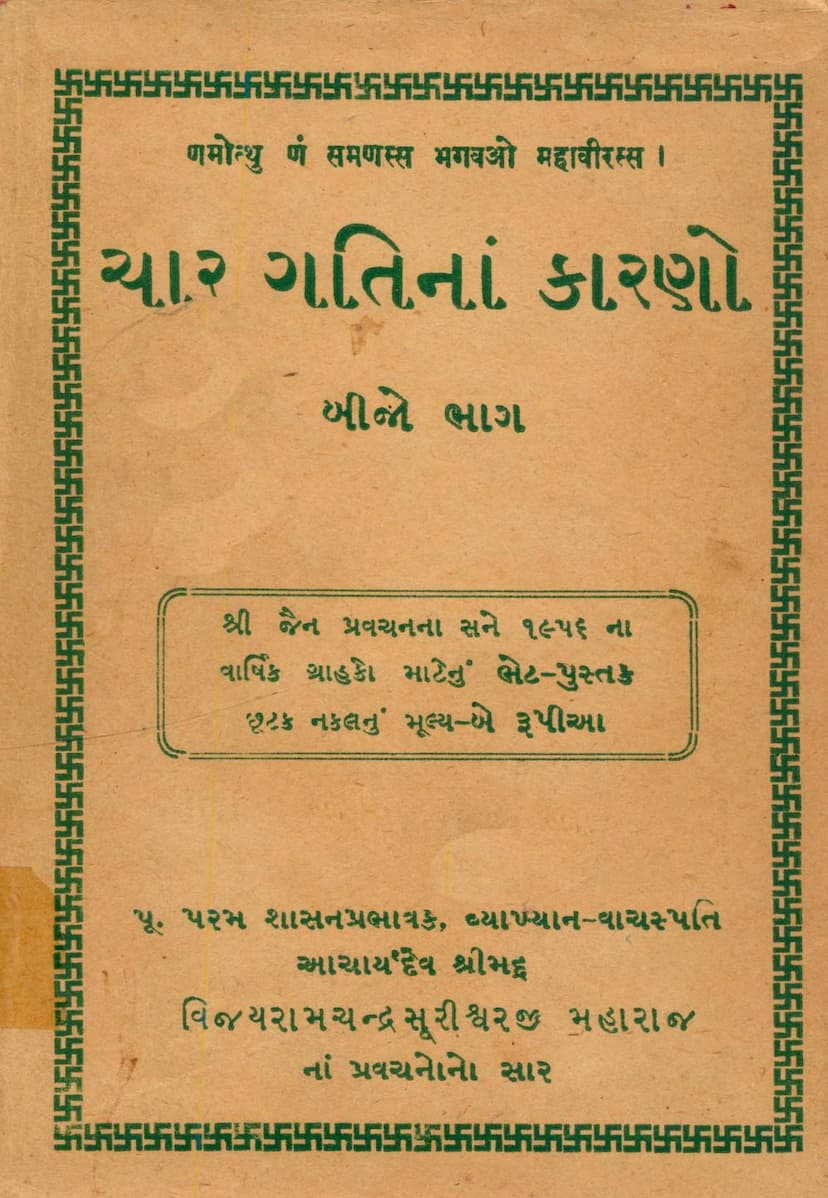Char Gatina Karno Part 02
Added to library: September 1, 2025

Summary
Here's a comprehensive summary of the Jain text "Char Gatina Karno Part 02" (The Causes of the Four States of Existence, Part 02) by Acharya Shrimad Vijay Ramchandrasurishwarji:
This book, the second part of "Char Gatina Karno," is a collection of discourses by the esteemed Acharya Shrimad Vijay Ramchandrasurishwarji, presented to the annual subscribers of the weekly publication "Shri Jain Pravachan" in 1956. The first part, published in 1955, laid the foundation for the discussion on the causes of rebirth in the four realms of existence (hellish beings, Tiryanch, humans, and celestial beings). This second part concludes the topic, delving deeper into the reasons for these migrations and offering guidance for achieving liberation.
The core message of the book emphasizes that our destiny in the cycle of birth and death is determined by our actions, specifically the karmas we bind. The text highlights the certainty of death and the subsequent rebirth, making it imperative for individuals to understand the causes of their migration and strive for the ultimate goal of Moksha (liberation).
Key Themes and Concepts Covered:
-
Understanding the Four States of Existence (Char Gati): The book systematically explores the karmic causes that lead to rebirth in the four realms:
- Hellish Beings (Naraka Gati): Detailed analysis of actions like intense violence, greed, attachment, malice, sinful thoughts, speech, and deeds that contribute to rebirth in the lower realms.
- Tiryanch (Animal/Sub-human Realm): The text identifies causes such as delusion (mithyatva), ignorance (agnan), uncontrolled senses and passions (kashayas), harmful speech (unmarga deshana), destruction of the right path (sanmarga nash), deceitful intentions (maya), and improper contemplation (artadhya).
- Human Realm (Manushya Gati): While humans are considered a fortunate realm for spiritual progress, the book outlines specific causes that lead to it, such as moderate vows, virtuous conduct, truthfulness, controlled senses, devotion to Deva, Guru, and Dharma, and positive mental states.
- Celestial Beings (Deva Gati): The text discusses causes like refined piety, devotion, auspicious thoughts, and virtuous actions that lead to celestial births.
-
The Role of Mithyatva (Delusion): A significant portion of the book is dedicated to understanding mithyatva as the root cause of all sins and the primary reason for the soul's wandering in samsara. The text stresses the importance of eradicating mithyatva and embracing samyaktva (right faith).
-
The Importance of Kashayas (Passions) and Senses: The discourses highlight how uncontrolled passions like anger, ego, deceit, and greed (kashayas) and the attachment to senses (indriyas) bind the soul to the cycle of birth and death. Overcoming these is presented as the path to liberation.
-
The Significance of Gati (Intentions) and Bhava (Mental States): The text repeatedly emphasizes that it is not just the action but the underlying intention (bhava) and mental state (parinam) that determines the karmic consequence. Pure intentions are crucial for positive outcomes.
-
The Three Types of Mithyatva: The book elaborates on the three primary types of delusion: abhigrahik (prejudiced belief), anabhigrahik (lack of conviction), and abhiniveshik (stubborn adherence to false beliefs). It also touches upon sanshayik (doubtful) and anabhog (unintentional) mithyatva.
-
The Power of Samyaktva (Right Faith): The text contrasts the results of mithyatva with the profound benefits of samyaktva, explaining how even a small act performed with samyaktva can yield immense positive results, while great austerities performed with mithyatva can be futile.
-
The Role of Leshya (Aura/Disposition): The six leshya (Kṛṣṇa, Nīla, Kāpota, Tejas, Padma, and Śukla) are explained in relation to their impact on actions and outcomes, with the darker leshya leading to lower births and the brighter ones to higher realms.
-
The Path to Liberation (Moksha): The ultimate aim is presented as liberation, which can only be achieved by overcoming passions and senses. The discourses encourage readers to cultivate right faith (samyaktva), right knowledge (samyag-jnana), and right conduct (samyak-charitra).
-
Practical Guidance for Householders: While the ultimate goal is liberation, the book also provides practical advice for householders, emphasizing the importance of ethical conduct, mindfulness in actions, the judicious use of wealth for good causes, and maintaining a righteous path even amidst worldly responsibilities.
-
The Importance of Right Intention and Effort: The discourses underscore that sincere intentions and consistent effort are paramount in spiritual progress. The teachings of the Tirthankaras are presented as the guiding light for this journey.
Narrative Style and Context:
The discourses are presented in a conversational and instructive manner, often using analogies and examples to illustrate complex Jain philosophical concepts. The text also includes historical anecdotes and references to Acharya Vijay Ramchandrasurishwarji's travels and experiences, adding a personal touch and demonstrating the practical application of Jain principles. The book's publication by Shri Jain Pravachan Pracharak Sarvajanik Dharmik Trust underscores its role in disseminating Jain teachings to the wider community.
In essence, "Char Gatina Karno Part 02" serves as a profound spiritual guide, urging readers to reflect on their actions, understand the karmic consequences, and actively engage in practices that lead to spiritual upliftment and ultimately, liberation from the cycle of birth and death.